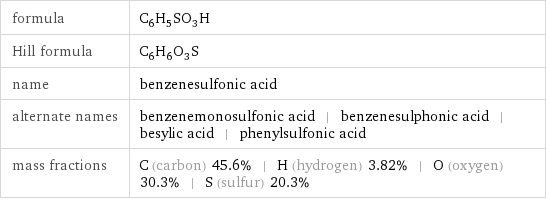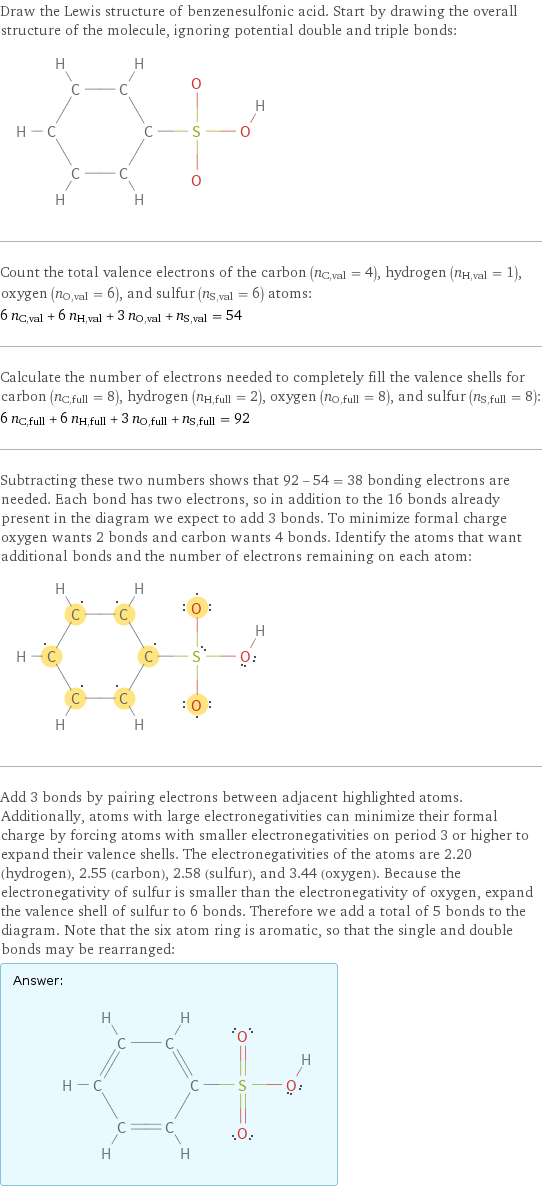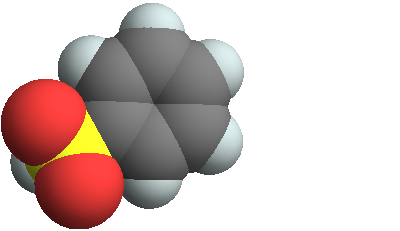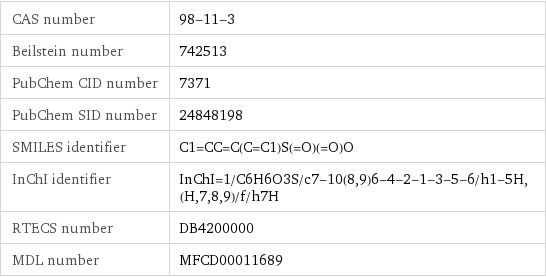Input interpretation

benzenesulfonic acid
Chemical names and formulas

formula | C_6H_5SO_3H Hill formula | C_6H_6O_3S name | benzenesulfonic acid alternate names | benzenemonosulfonic acid | benzenesulphonic acid | besylic acid | phenylsulfonic acid mass fractions | C (carbon) 45.6% | H (hydrogen) 3.82% | O (oxygen) 30.3% | S (sulfur) 20.3%
Lewis structure

Draw the Lewis structure of benzenesulfonic acid. Start by drawing the overall structure of the molecule, ignoring potential double and triple bonds: Count the total valence electrons of the carbon (n_C, val = 4), hydrogen (n_H, val = 1), oxygen (n_O, val = 6), and sulfur (n_S, val = 6) atoms: 6 n_C, val + 6 n_H, val + 3 n_O, val + n_S, val = 54 Calculate the number of electrons needed to completely fill the valence shells for carbon (n_C, full = 8), hydrogen (n_H, full = 2), oxygen (n_O, full = 8), and sulfur (n_S, full = 8): 6 n_C, full + 6 n_H, full + 3 n_O, full + n_S, full = 92 Subtracting these two numbers shows that 92 - 54 = 38 bonding electrons are needed. Each bond has two electrons, so in addition to the 16 bonds already present in the diagram we expect to add 3 bonds. To minimize formal charge oxygen wants 2 bonds and carbon wants 4 bonds. Identify the atoms that want additional bonds and the number of electrons remaining on each atom: Add 3 bonds by pairing electrons between adjacent highlighted atoms. Additionally, atoms with large electronegativities can minimize their formal charge by forcing atoms with smaller electronegativities on period 3 or higher to expand their valence shells. The electronegativities of the atoms are 2.20 (hydrogen), 2.55 (carbon), 2.58 (sulfur), and 3.44 (oxygen). Because the electronegativity of sulfur is smaller than the electronegativity of oxygen, expand the valence shell of sulfur to 6 bonds. Therefore we add a total of 5 bonds to the diagram. Note that the six atom ring is aromatic, so that the single and double bonds may be rearranged: Answer: | |
3D structure

3D structure
Basic properties

molar mass | 158.2 g/mol phase | solid (at STP) melting point | 50 °C boiling point | 319 °C density | 1.32 g/cm^3 solubility in water | very soluble
Units

Solid properties (at STP)

density | 1.32 g/cm^3
Units

Chemical identifiers

CAS number | 98-11-3 Beilstein number | 742513 PubChem CID number | 7371 PubChem SID number | 24848198 SMILES identifier | C1=CC=C(C=C1)S(=O)(=O)O InChI identifier | InChI=1/C6H6O3S/c7-10(8, 9)6-4-2-1-3-5-6/h1-5H, (H, 7, 8, 9)/f/h7H RTECS number | DB4200000 MDL number | MFCD00011689
Safety properties

flash point | 110 °C

DOT hazard class | 8 DOT numbers | 2585
Toxicity properties

RTECS classes | primary irritant